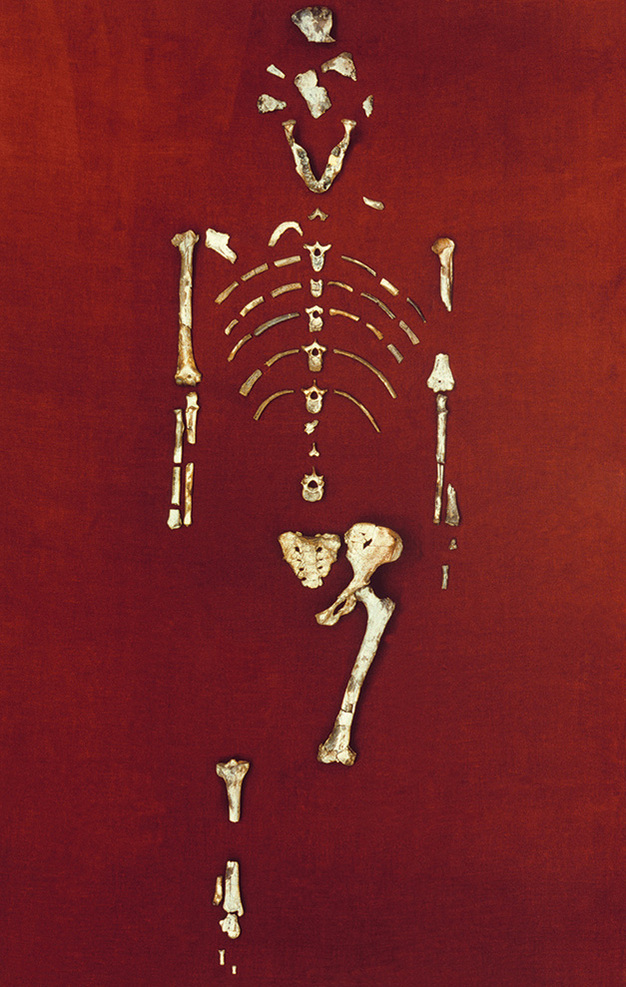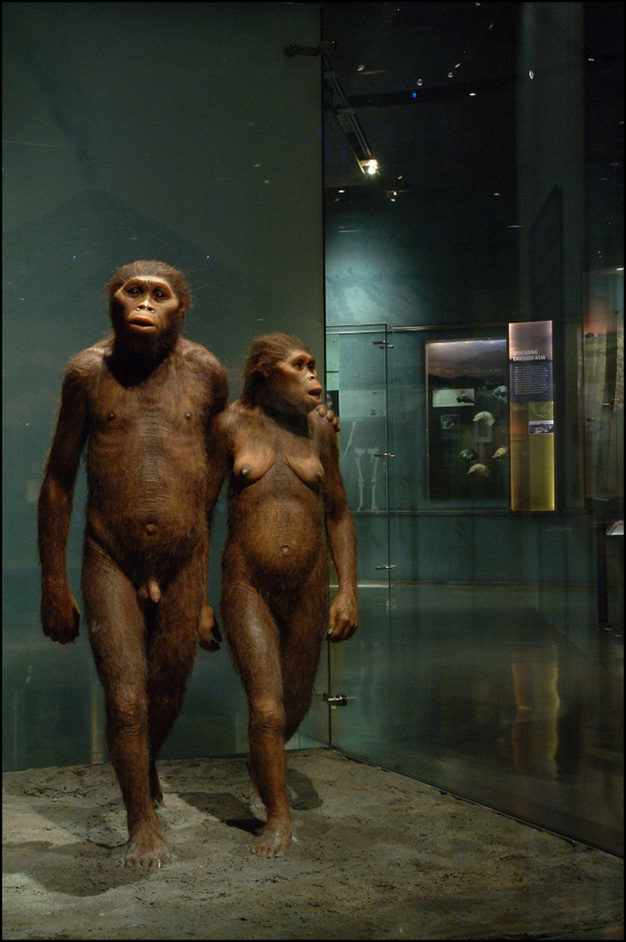Bipedalism: One of Lucy’s most significant contributions to paleoanthropology is the evidence of bipedal locomotion. Her pelvis, femur, and knee joints exhibit adaptations for upright walking, such as a bicondylar angle in the femur that aligns the knee under the body’s midline, facilitating balance. The shape of her pelvis, broader and shorter than that of apes, further supports bipedalism. These features confirmed that bipedalism evolved before significant brain enlargement, challenging earlier assumptions that large brains drove upright walking.
Arboreal Adaptations: Despite her bipedal capabilities, Lucy retained ape-like features suggesting arboreal behavior. Her long arms, curved finger bones, and conical rib cage indicate she was adept at climbing trees, likely for foraging, nesting, or escaping predators. A 2016 study using micro-CT scans of Lucy’s arm bones revealed exceptional strength, suggesting she regularly hauled herself up branches. This dual adaptation—bipedalism on the ground and climbing in trees—highlights the versatility of A. afarensis in a mixed woodland-savanna environment.
Sexual Dimorphism: Lucy is identified as female based on her pelvic structure and small size, which contrast with larger A. afarensis specimens presumed to be male. This sexual dimorphism, evident in size differences at Hadar, suggests social structures similar to those of modern gorillas, where larger males may have competed for mates.
Lucy’s Place in the Human Family Tree
When Lucy was discovered, she was initially thought to be a direct ancestor of modern humans (Homo sapiens), potentially the “mother of humanity”. In 1978, Johanson and colleagues classified her as part of a new species, Australopithecus afarensis, distinct from other known australopiths like A. africanus. They proposed that A. afarensis was the last common ancestor of both the Homo lineage and the robust australopiths (Paranthropus). This hypothesis positioned Lucy’s species as a pivotal evolutionary intermediary.
However, subsequent discoveries have complicated this view. Fossils like Ardipithecus ramidus (4.4 million years old) and Australopithecus anamensis (4.2–3.9 million years old) suggest a more bush-like human family tree, with multiple hominin species coexisting. Some researchers now view A. afarensis as a close relative rather than a direct ancestor, possibly a “great-great-great-aunt”. Nevertheless, Lucy remains a strong candidate for an ancestral role due to her anatomical similarities with later hominins, such as a mandible found in Hadar in 2013 that bridges A. afarensis and early Homo.
The discovery of the “First Family” at Hadar’s Afar Locality 333 in 1975, comprising over 200 fossils from at least 17 individuals, further enriched our understanding of A. afarensis. This group, dated to slightly over 3.2 million years ago, provided evidence of population-level variation and social dynamics. Additionally, fossilized footprints at Laetoli, Tanzania, dated to 3.7 million years ago, corroborate the bipedal capabilities of A. afarensis, reinforcing Lucy’s significance.
Lucy’s Life and Death
Reconstructing Lucy’s life offers a glimpse into the world of A. afarensis. Carbon isotope analysis of A. afarensis tooth enamel suggests a diverse diet, including savanna-based foods like grasses and sedges, alongside fruits and leaves from trees. This dietary flexibility likely contributed to the species’ survival for nearly 700,000 years (3.7–3 million years ago).
Lucy’s cause of death remains speculative. Her skeleton shows minimal postmortem damage, with only a single carnivore tooth mark on her pubic bone, ruling out predation as a likely cause. A 2016 study by John Kappelman and colleagues proposed that Lucy died from a fall from a tree, based on CT scans revealing fractures in her humerus and other bones consistent with a high-impact fall. However, this hypothesis is controversial, with critics like Donald Johanson and Timothy White arguing that the fractures could result from post-fossilization geological processes. The debate underscores the challenges of interpreting ancient trauma.
Scientific and Cultural Impact
Lucy’s discovery marked a turning point in paleoanthropology. Before 1974, the human evolutionary timeline was poorly understood, with fossils like A. africanus (2.5 million years old) dominating discussions. Lucy extended the timeline back nearly a million years and provided concrete evidence that bipedalism preceded brain expansion, disproving earlier Darwinian assumptions. Her skeleton served as a template for reconstructing other A. afarensis fossils, enhancing comparative studies.
Culturally, Lucy became an icon. Her name, inspired by a Beatles song, and her relatable stature endeared her to the public. Exhibitions of her fossils, such as the 2007–2013 U.S. tour “Lucy’s Legacy: The Hidden Treasures of Ethiopia,” drew millions, though they sparked debate over the risks to her fragile bones. Today, the original fossils are housed in the National Museum of Ethiopia, with casts displayed globally, including at the Cleveland Museum of Natural History and the American Museum of Natural History.
Lucy also galvanized funding and interest in African paleoanthropology, fostering a new generation of researchers, including Ethiopian scientists like Zeresenay Alemseged, who discovered “Lucy’s baby,” a 3.3-million-year-old A. afarensis child. Her legacy underscores Africa’s role as the cradle of humankind.
Ongoing Research and Future Directions
Fifty years after her discovery, Lucy continues to inspire research. Advances in imaging technologies, such as 3D reconstructions and micro-CT scans, have revealed new details about her brain development and locomotion. Studies of her muscle structure suggest impressive strength, challenging assumptions about her physical capabilities. Meanwhile, discoveries of older hominins, like Sahelanthropus tchadensis (7 million years old), continue to refine our understanding of the human family tree.
Future research may clarify Lucy’s exact position in our ancestry and resolve debates about her lifestyle and death. Interdisciplinary approaches, combining paleogenetics, biomechanics, and environmental reconstruction, promise to deepen our understanding of A. afarensis and its world.
Conclusion
Lucy, the 3.2-million-year-old Australopithecus afarensis skeleton, remains a cornerstone of human evolutionary studies. Her discovery illuminated the origins of bipedalism, reshaped the human family tree, and captivated the world’s imagination. While her status as a direct ancestor is debated, her anatomical insights and cultural impact are undeniable. As paleoanthropology advances, Lucy’s legacy endures, reminding us of our shared origins and the ongoing quest to understand what it means to be human.
Sources:
Institute of Human Origins, Arizona State University. “Lucy’s Story.” https://iho.asu.edu/about/lucys-story[](https://iho.asu.edu/about/lucys-story)
Wikipedia. “Lucy (Australopithecus).” https://en.wikipedia.org/wiki/Lucy_(Australopithecus)[](https://en.wikipedia.org/wiki/Lucy_%28Australopithecus%29)
National Geographic. “Get Facts on the Early Human Ancestor Lucy.” https://www.nationalgeographic.com/science/article/lucy-facts-on-early-human-ancestor[](https://www.nationalgeographic.com/history/article/lucy-facts-on-early-human-ancestor)
Scientific American. “Fossil Human Ancestor ‘Lucy’ Remains Pivotal 50 Years after Discovery.” https://www.scientificamerican.com/article/fossil-human-ancestor-lucy-remains-pivotal-50-years-after-discovery/[](https://www.scientificamerican.com/article/fossil-human-ancestor-lucy-remains-pivotal-50-years-after-discovery/)
CNN. “How did Lucy, our early human ancestor, die?” https://www.cnn.com/2016/08/29/health/lucy-human-ancestor-cause-of-death[](https://www.cnn.com/2016/08/29/health/lucy-early-human-ancestor-cause-of-death/index.html)
Nature. “Lucy: A marvelous specimen.” https://www.nature.com/scitable/knowledge/library/lucy-a-marvelous-specimen-13512986/[](https://www.nature.com/scitable/knowledge/library/lucy-a-marvelous-specimen-135716086/)
Natural History Museum. “Australopithecus afarensis, Lucy’s species.” https://www.nhm.ac.uk/discover/australopithecus-afarensis-lucy-species.html[](https://www.nhm.ac.uk/discover/australopithecus-afarensis-lucy-species.html)
Science. “Was Lucy the mother of us all? Fifty years after discovery, famed skeleton has rivals.” https://www.science.org/content/article/was-lucy-mother-us-all-fifty-years-after-discovery-famed-skeleton-has-rivals[](https://www.science.org/content/article/was-lucy-mother-us-all-fifty-years-discovery-famed-skeleton-rivals)
History.com. “How the ‘Lucy’ Fossil Rewrote the Story of Human Evolution.” https://www.history.com/news/lucy-australopithecus-fossil-discovery-human-evolution[](https://www.history.com/articles/lucy-fossil-discovery-human-origins)
Science Friday. “50 Years Of Science With Lucy, Our Famous Early Ancestor.” https://www.sciencefriday.com/segments/lucy-fossil-discovery-50-years/[](https://www.sciencefriday.com/segments/lucy-human-ancestor-50-anniversary/)
Washington Post. “How Lucy, a 3-million-year-old fossil, changed our view of human evolution.” https://www.washingtonpost.com/science/2024/11/22/lucy-fossil-discovery-human-evolution/[](https://www.washingtonpost.com/science/interactive/2024/evolution-fossil-lucy-human-ancestor/)
Cleveland Museum of Natural History. “An Iconic Discovery: Celebrating the Story of Lucy.” https://www.cmnh.org/lucy-50[](https://www.cmnh.org/learn/science-blog/2024/11/24/a-groundbreaking-discovery-turns-50-celebrating-the-story-of-lucy)















































